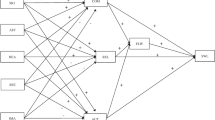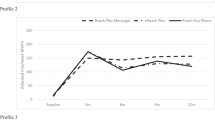Abstract
Deci and Ryan (2002) posit the importance of three sources of interpersonal support processes that when fostered authentically enhances psychological need fulfillment and well-being. Guided by Deci and Ryan’s (2002) contentions, the purpose of the study was to determine if interpersonal supports provided by exercise instructors was associated with well-being via the satisfaction of basic psychological needs in persons living with osteoporosis. Using a non-experimental research design, participants (N = 280) completed a self-report instrument at the mid-point of a 10 week structured OsteoFit exercise class. Results generally supported Deci and Ryan’s (2002) hypothesized sequence. Interpersonal supports demonstrated a pattern of small-to-moderate correlations with psychological need fulfillment (r 12 ’s ranged from .37 to .47) and well-being (r 12 ’s ranged from −.07 to .26). Multiple mediation analysis revealed that variance in psychological need satisfaction (R2 = 0.14 to 0.22) and markers of well-being (R2 = 0.03 to 0.32) was explained by the proposed model. This investigation provides support for the role of interpersonal supports in a clinical population where sustained and regular exercise is associated with physical and psychological health consequences. The importance of creating supportive environments within OsteoFit classes to optimize effects on well-being is highlighted.

Similar content being viewed by others
Notes
Directors of the Osteofit program served a gatekeeper role in the recruitment phase of this study and had no direct input into the research questions investigated or the manner in which the data were analysed and reported within this study.
References
Acevedo, E. O., & Ekkekakis, P. (2006). Psychobiology of physical activity. Champaign: Human Kinetics.
Anderson, J. C., & Gerbing, D. W. (1988). Structural equation modeling in practice: A review and recommended two-step approach. Psychological Bulletin, 103, 411–423.
Bandura, A. (1986). Social foundations of thought and action: A social cognitive theory. Englewood Cliffs, N.J.: Prentice-Hall.
Bartl, R., & Frisch, B. (2009). Osteoporosis: Diagnosis, prevention and therapy (2nd ed.,). Berlin, Heidelberg: Springer. doi:10.1007/978-3-540-79527-8.
Baumeister, R. F., & Leary, M. R. (1995). The need to belong: desire for interpersonal attachments as a fundamental human motivation. Psychological Bulletin, 117, 497–529.
Biddle, S. J. H., & Ekkekakis, P. (2005). Physically active lifestyles and well-being. In F. A. Huppert, B. Keverne, & N. Baylis (Eds.), The science of well-being (pp. 140–168). Oxford: Oxford University Press.
Brown, A. (2006). Confirmatory factor analysis for applied research. New York: Guilford Press.
Cauley, J. A. (2013). Public health impact of osteoporosis. The Journals of Gerontology Series: A Biological Sciences and Medical Sciences, 68, 1243–1251. doi:10.1093/gerona/glt093.
Cerin, E. (2010). Ways of unraveling how and why physical activity influences mental health through statistical mediation analyses. Mental Health & Physical Activity, 3, 51–60. doi:10.1016/j.mhpa.2010.06.002.
deCharms, R. (1968). Personal causation: The internal affective determinants of behavior. New York: Academic Press.
Deci, E. L., & Ryan, R. M. (2002). Handbook of self-determination research. Rochester: The University of Rochester Press.
Diamantopoulos, A., & Siguaw, J. (2000). Introducing LISREL. London: SAGE Publications Ltd..
Diener, E., Wirtz, D., Tov, W., Kim-Prieto, C., Choi, D., Oishi, S., & Biswas-Diener, R. (2009). New measures of well-being: flourishing and positive and negative feelings. Social Indicators Research, 39, 247–266. doi:10.1007/s11205-009-9493-y.
Duda, J. L., Williams, G. C., Ntoumanis, N., Daley, A., Eves, F. F., Mutrie, N., Rouse, P. C., Lodhia, R., Blamely, R. V., & Jolly, K. (2014). Effects of a standard provision versus an autonomy supportive exercise referral programme on physical activity, quality of life and well-being indicators: a cluster randomised controlled trial. International Journal of Behavioral Nutrition and Physical Activity, 11, 1–28.
Edmunds, J., Ntoumanis, N., & Duda, J. L. (2006). A test of self-determination theory in the exercise domain. Journal of Applied Social Psychology, 36, 2240–2265. doi:10.1111/j.0021-9029.2006.00102.x.
Fredrickson, B. L. (2001). The role of positive emotions in positive psychology. the broaden-and-build theory of positive emotions. American Psychologist, 56, 218–226.
Giangregorio, L. M., Macintyre, N. J., Heinonen, A., Cheung, A. M., Wark, J. D., Shipp, K., McGill, S., … Papaioannou, A. (2014). Too fit To fracture: A consensus on future research priorities in osteoporosis and exercise. Osteoporosis International, 25, 382–835. doi:10.1007/s00198-014-2652-2.
Giangregorio, L. M., McGill, S., Wark, J. D., Laprade, J., Heinonen, A., Ashe, M. C., McIntyre, N. J., … Papaioannou, A. (2015). Too fit to fracture: outcomes of a Delphi consistent process on physical activity and exercise recommendations for adults with osteoporosis with or without vertebral fractures. Osteoporosis International, 26, 891–910. doi:10.1007/s00198-014-2881-4.
Gunnell, K. E., Mack, D. E., Wilson, P. M., & Adachi, J. D. (2011). Psychological needs as mediators? the relationship between physical activity and well-being in people diagnosed with osteoporosis. Research Quarterly for Exercise and Sport, 82, 794–798. doi:10.1080/02701367.2011.10599817.
Gunnell, K. E., Crocker, P. R. E., Mack, D. E., Wilson, P. M., & Zumbo, B. D. (2014). Goal contents, motivational regulations, psychological needs, well-being, and physical activity: A test of self-determination theory over 6 months. Psychology of Sport and Exercise, 15, 19–29. doi:10.1016/j.psychsport.2013.08.005.
Hayes, A. (2013). Introduction to mediation, moderation and conditional process analysis: A regression based approach. New York: Guilford Press.
Hernlund, E., Svedbom, A., Ivergard, M., Compston, J., Cooper, C., Stenmark, J., … Kanis, A. (2013). A report prepared in collaboration with the International Osteoporosis Foundation (IOF) and the European Federation of Pharmaceutical Industry Associations (EFPIA). Archives of Osteoporosis, 8, 136. doi:10.1007/s11657-013-0136-1.
Hill, A. B. (1965). The environment and disease: association or causation? Proceedings of the Royal Society of Medicine, 58, 295–300.
Hone, L., Jarden, A., & Schofield, G. (2014). Psychometric properties of the flourishing scale in a New Zealand sample. Social Indicators Research, 119, 1031–1045. doi:10.1007/s11205-013-0501-x.
Hu, L., & Bentler, P. M. (1999). Cutoff criteria for fit indexes in covariance structure analysis: conventional criteria versus new alternatives. Structural Equation Modeling, 6, 1–55.
Johnell, O., & Hertzman, P. (2006). What evidence is there for the prevention and screening osteoporosis? WHO Regional Office for Europe: Copenhagen. http://www.euro.who.int/__data/assets/pdf_file/0009/74475/E88668.pdf.
Klain, I. P., de Matos, D. G., Leitão, J. C., Cid, L., & Moutão, J. (2015). Self-determination and physical exercise adherence in the context of fitness academies and personal training. Journal of Human Kinetics, 46, 241–249. doi:10.1515/hukin-2015-0052.
Li, W. C., Chen, Y. C., Yang, R. S., & Tsauo, J. Y. (2009). Effects of exercise programmes on quality of life in osteoporotic and osteopenic postmenopausal women: A systematic review and meta-analysis. Clinical Rehabilitation, 23, 888–896. doi:10.1177/0269215509339002.
López-Walle, L., Balaguer, I., Castillo, I., & Tristán, J. (2012). Autonomy support, basic psychological needs and well-being in Mexican athletes. The Spanish Journal of Psychology, 15, 1283–1292. doi:10.5209/rev_SJOP.2012.v15.n3.39414.
Mack, D. E., Wilson, P. M., Gunnell, K. E., Gilchrist, J. D., Kowalski, K. C., & Crocker, P. R. E. (2012). Health-enhancing physical activity: Associations with markers of well-being. Applied Psychology: Health & Well-Being, 4, 127–150. doi:10.1111/j.1758-0854.2012.01065.xl.
MacKinnon, D. P. (2008). Introduction to statistical mediation analysis. Mahwah: Erlbaum.
Mackinnon, A., Jorm, A. F., Christensen, H., Korten, A. E., Jacomb, P. A., & Rodgers, B. (1999). A short form of the positive and negative affect schedule: evaluation of factorial validity and invariance across demographic variables in a community sample. Personality and Individual Differences, 27, 405–416. doi:10.1016/S0191-8869(98)00251-7.
Mackinnon, D. P., Lockwood, C. M., Hoffman, J. M., West, S. G., & Sheets, V. (2002). A comparison of methods to test mediation and other intervening variable effects. Psychological Methods, 7, 83–104. doi:10.1037/1082-989X.7.1.83.
Markland, D. A., & Tobin, V. J. (2010). Need support and behavioural regulations for exercise among exercise referral scheme clients: the mediating role of psychological need satisfaction. Psychology of Sport & Exercise, 11, 91–99. doi:10.1016/j.psychsport.2009.07.001.
McArdle, J. J. (2009). Latent variable modeling of differences and changes with longitudinal data. Annual Review of Psychology, 60, 577–605. doi:10.1146/annurev.psych.60.110707.163612.
Pedhauzer, E., & Pedhauzer Schmelkin, L. (1991). Measurement, design, & analysis. Hillsdale: Lawrence Erlbaum Associates.
Preacher, K. J., & Hayes, A. F. (2008). Asymptotic and resampling strategies for assessing and comparing indirect effects in multiple mediator models. Behavior Research Methods, 40, 879–891. doi:10.3758/BRM.40.3.879.
Puente, R., & Anshel, M. H. (2010). Exercisers’ perceptions of their fitness instructor’s interacting style, perceived competence, and autonomy as a function of self-determined regulation to exercise, enjoyment, affect and exercise frequency. Scandinavian Journal of Psychology, 51, 38–45. doi:10.1111/j.1467-9450.2009.00723.x.
Quested, E., & Duda, J. L. (2010). Exploring the social-environmental determinants of well-and ill-being in dancers: A test of basic needs theory. Journal of Sport & Exercise Psychology, 32, 39–60.
Rahman, R. J., Thøgersen-Ntoumani, C., Thatcher, J., & Doust, J. (2011). Changes in need satisfaction and motivation orientation as predictors of psychological and behavioural outcomes in exercise referral. Psychology & Health, 26, 1521–1539. doi:10.1080/08870446.2010.538849.
Sherrington, C., Tiedemann, A., Fairhall, N., Close, J., & Lord, S. R. (2011). Exercise for preventing falls in older adults: An updated exercise for improving outcomes after osteoporotic vertebral fracture meta-analysis and best practice recommendations. NSW Public Health Bulletin, 22, 78–83. doi:10.1071/NB10056.
Shih, T.-H., & Fan, X. (2008). Comparing response rates from web and mail surveys: A meta-analysis. Field Methods, 20, 249–271. doi:10.1177/1525822X08317085.
Streiner, D. L., & Norman, G. R. (2008). Health measurement scales: A practical guide to their development and use (4th ed., ). Toronto: Oxford University Press.
Vansteenkiste, M., Niemiec, C., & Soenens, B. (2010). The development of the five mini-theories of self-determination theory: An historical overview, emerging trends, and future directions. In T. Urdan, & S. Karabenick (Eds.), Advances in motivation and achievement, The decade ahead (vol. 16, pp. 105–166). UK: Emerald Publishing.
White, R. W. (1963). Ego and reality in psychoanalytic theory. New York: International Universities Press.
Wilson, P. M., Longley, K., Muon, S., Rodgers, W. M., & Murray, T. C. (2006a). Examining the contributions of perceived psychological need fulfillment to well-being in exercise. Journal of Applied Biobehavioral Research, 11, 243–264. doi:10.1111/j.1751-9861.2007.00008.x.
Wilson, P. M., Rogers, W. T., Rodgers, W. M., & Wild, T. C. (2006b). The psychological need satisfaction in exercise scale. Journal of Sport & Exercise Psychology, 28, 231–251.
Wojtek, J., David, N., Maria, A., Christopher, T., Claudio, R., George, J., & James, S. (2009). Exercise and physical activity for older adults. Journal of the American College of Sports Medicine, 41, 1510–1530.
World Health Organization (2007). Assessment of osteoporosis at the primary health care level. summary report of a WHO Scientific Group. WHO, Geneva. Retrieved from www.who.int/chp/topics/rheumatic/en/index.html.
Acknowledgments
Diane E. Mack and Philip M. Wilson are with the Centre for Bone and Muscle Health at Brock University. The authors thank Jenna D. Gilchrist for her assistance with data collection. We are grateful to the participants who willingly gave their time and The British Columbia Women’s Hospital and Health Centre OsteoFit program.
Author information
Authors and Affiliations
Corresponding author
Rights and permissions
About this article
Cite this article
Mack, D.E., Gunnell, K.E., Wilson, P.M. et al. Well-Being in Group-Based Exercise Classes: Do Psychological Need Fulfillment and Interpersonal Supports Matter?. Applied Research Quality Life 12, 89–102 (2017). https://doi.org/10.1007/s11482-016-9454-y
Received:
Accepted:
Published:
Issue Date:
DOI: https://doi.org/10.1007/s11482-016-9454-y




